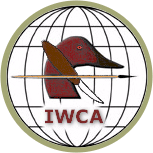IWCA Canvasback, Part 1
Carver Byrn WatsonText and photos by Bill Einsig
IWCA Canvasback Part 1, Cutting the Rough-outThe first article in our IWCA Canvasback series shows the steps for laying out and cutting the body. Byrn Watson does the work as we follow each step with photos and text. |
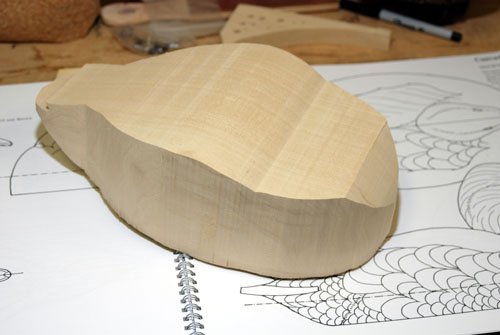 |
| IWCA Canvasback |
| Part 1, Cutting the Rough-out |
|
In this first article of a lengthy series, Byrn Watson uses a Pat Godin pattern to cut the roughout of our Canvasback drake decoy. We plan to photograph and describe all the steps from block to bird, as carvers from across the country take their turn with this decoy. Want to put your mark on this bird? Your help would be appreciated. Our IWCA Canvasback will, tentatively, attend Core Sound in December 2009, East Carolina in February 2010, and Rappahannock in March 2010. Bring your tools! Give us an hour or so, and we'll put your name on this bird. |
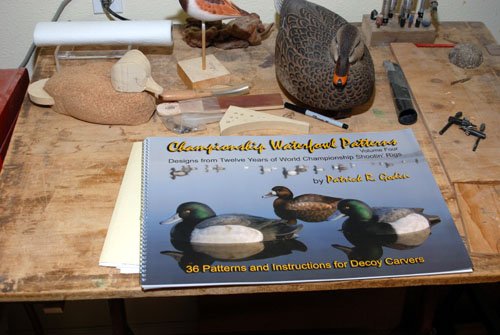 |
|
1. After deciding to use a Canvasback drake for this instructional project, Byrn used a quality pattern familiar to most carvers. The only change Byrn made in the pattern was to allow wood at the rear of the bird so that the primary tips could be longer with a more graceful slope to the water. Various reference photographs showed the primaries in this position, and Byrn preferred this small modification. |
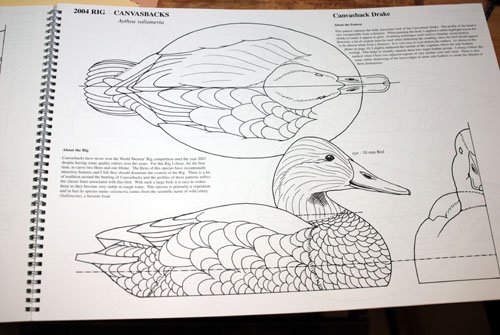 |
|
2. Byrn copied the pattern for a drake Can using the directions in the book to obtain life-size top-view and side-view patterns. These life-size patterns then determine the size of the wood block he will need. |
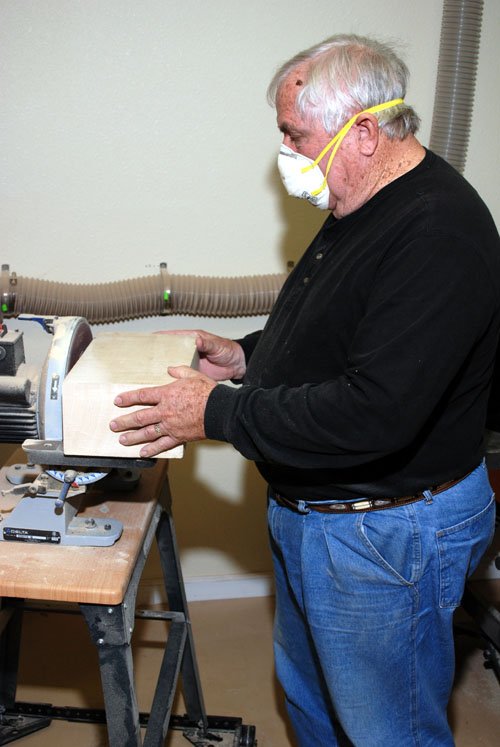 |
|
3. Before applying the pattern, the block is sanded to square it up with flat, even sides. The body could have been cut from a block of boards, but, in this case, Byrn used a solid block of tupelo. |
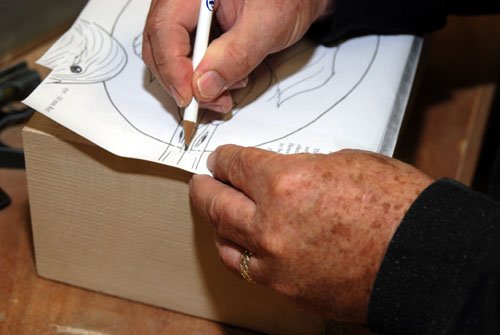 |
|
4. After the block is squared, the top view is placed on the top of the block and positioned so that the entire pattern falls on the block. Here, Byrn presses through the paper to mark the wood at the very front edge of the body. |
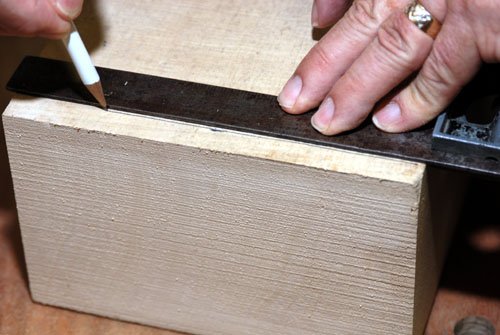 |
|
5. Next, Byrn uses a square to draw a line across the block at the mark showing the front edge of the body. |
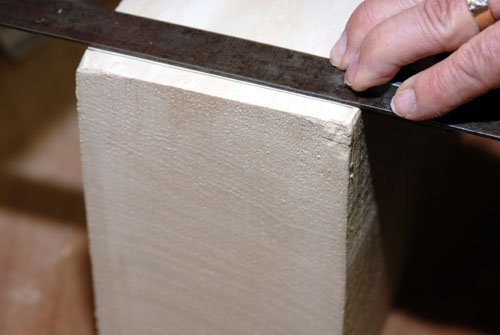 |
|
6. The line is carried over to the side of the block where the side view will be applied. |
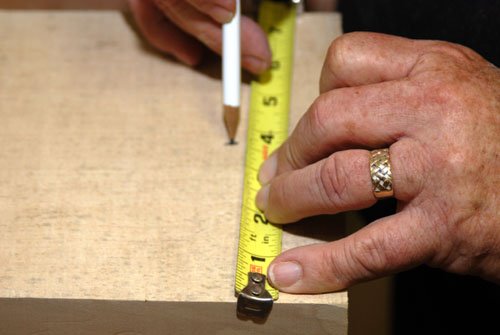 |
|
7. Next, Byrn measures the exact width of the block to determine its midpoint. This block is 7.5 inches wide, so the midpoint is marked at 3.75 inches. (Why is this picture out of focus? Read "Fuzzy Tape" in the Photo Group Message Board.) |
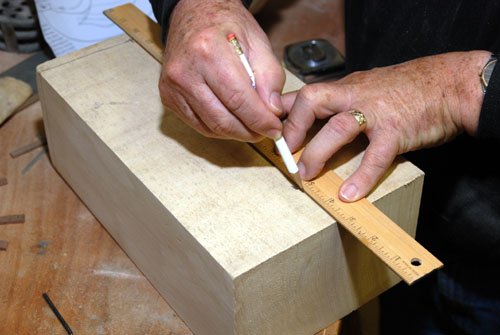 |
|
8. After marking two more reference points, Byrn draws the line indicating the centerline of the block. This line will help align the pattern on the block, and it will be critical as the decoy takes shape. |
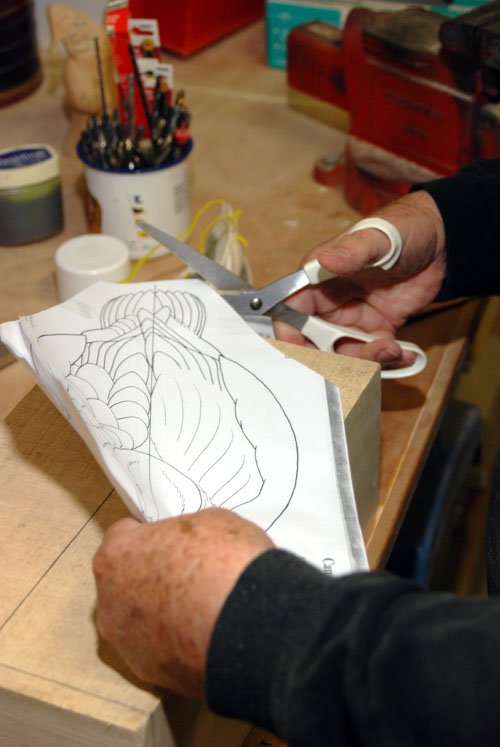 |
|
9. Byrn cuts away much of the waste paper surrounding the body pattern and trims to the end of the tail. |
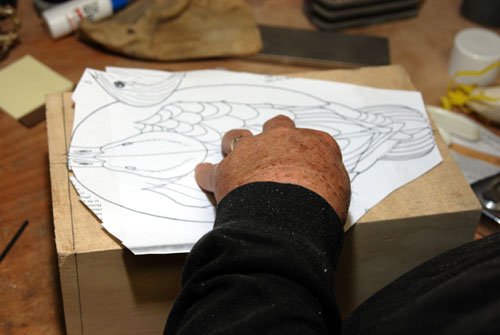 |
|
10. By aligning the centerline of the pattern with the centerline of the block, he can place the pattern and mark the rear pattern edge. |
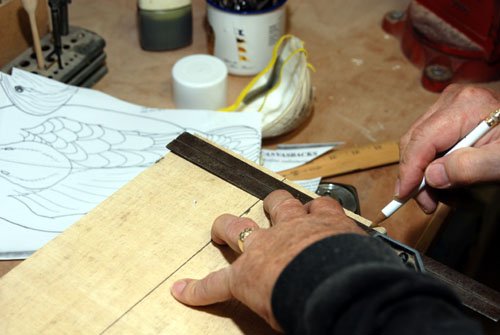 |
|
11. Using the square, Byrn draws a line indicating the rear end of the pattern. Again, he carries that line to the side of the block. |
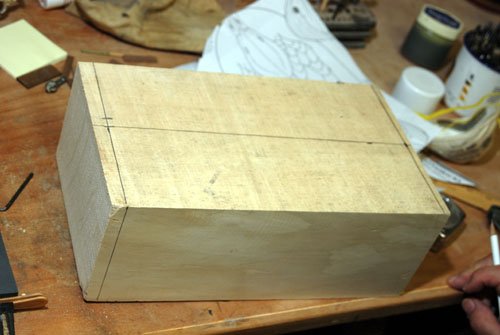 |
|
12. Here is the block with measurements and lines to help place the pattern on the wood. |
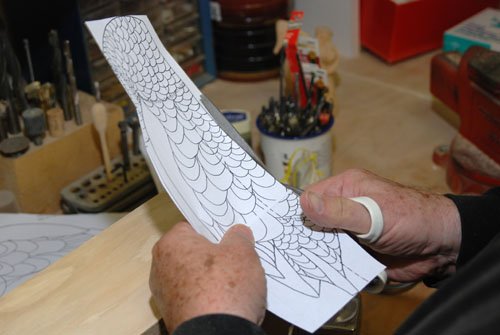 |
|
13. Both the top and side patterns are now trimmed of all waste paper outside of the body line. Here, paper next to the bottom of the bird is carefully cut away. |
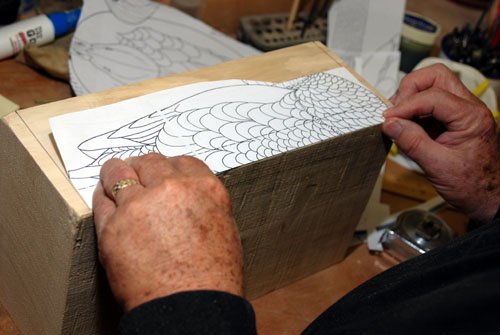 |
|
14. Because this block has a flat bottom without problem areas, Byrn decides to use the bottom of the block as the bottom of the decoy. So, he aligns the bottom of the side pattern with the bottom edge of the block. |
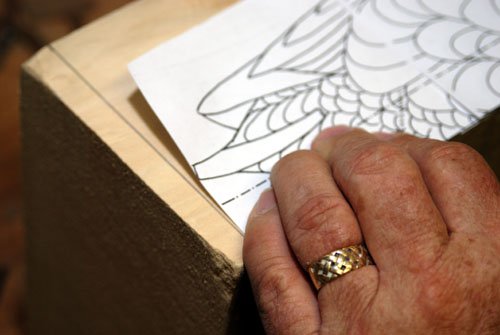 |
|
15. Lay the side pattern on the block to see if it fits within the front and rear reference lines drawn from the top of the block. |
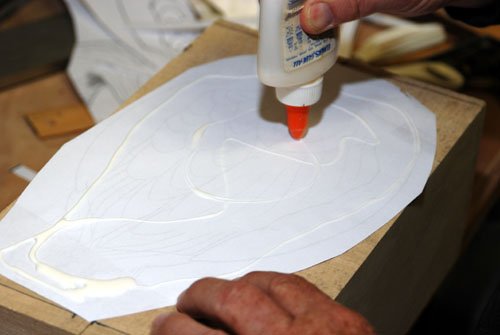 |
|
16. Apply glue to the back of the top pattern. The pattern must remain attached to the block as the body is cut on the band saw. |
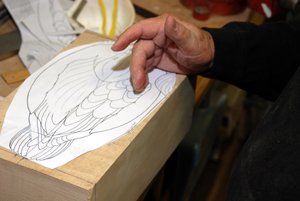 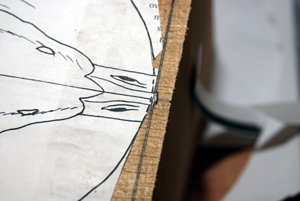 |
|
17. Smooth the pattern being certain the centerline of the pattern aligns with the centerline drawn on the block. Match the centerlines at the front and rear of the duck's body. |
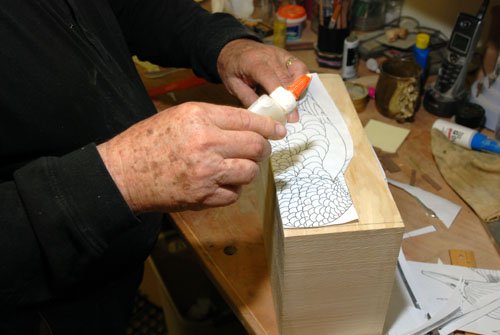 |
|
18. Attach the side view pattern in the same way using the bottom of the block and two reference lines as guides. Finally, be certain the head end of the side view is on the same end of the block as the head end of the top view. (Sound obvious? Sure, but it's an easy mistake.) |
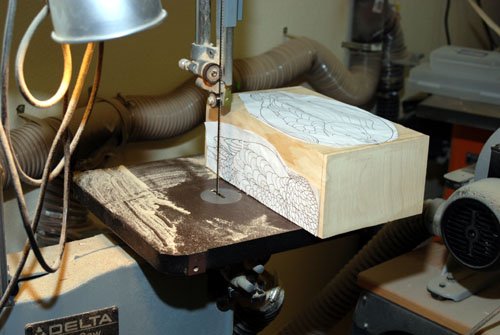 |
|
19. With the patterns attached firmly in place, the block is ready for the saw. Let's cut the top pattern first. |
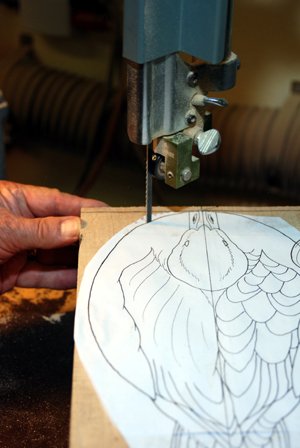 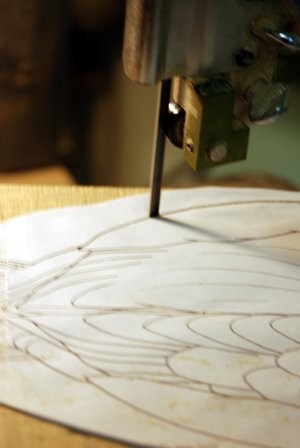 |
|
20. Byrn begins his cut at the front centerline and follows the edge of the body pattern along the left side. Some carvers prefer to leave extra wood on the body by sawing just outside the line. Others, like Byrn in this case, cut right on the line. |
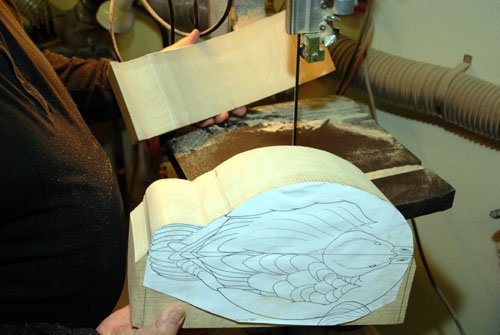 |
|
21. Byrn saws to the centerline on the rear of the bird and separates the waste piece on the left side. He'll need that scrap piece for one more step, so he sets it aside for now. |
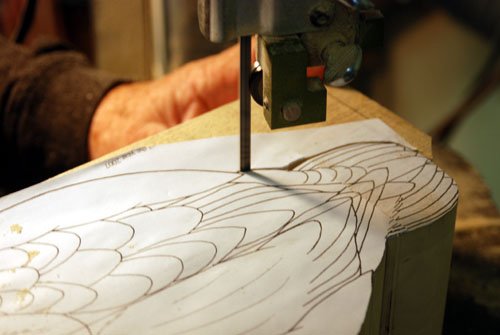 |
|
22. In the same way, continue cutting along the pattern line on the right side of the body. Finally, remove the scrap but save it for the next step. |
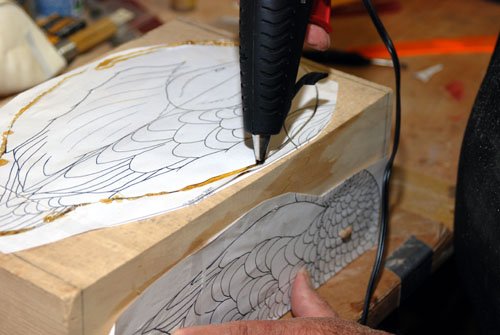 |
|
23. In order to band saw the side view pattern, the block must be squared with a flat bottom and pattern on top. Some carvers leave small areas uncut, as they saw the top view, so the side pieces remain attached. Others nail the side pieces back onto the body placing nails in waste areas where the saw will not cut. Byrn uses yet another method. He reassembles all three pieces and runs a bead of hot glue around the cut. This hardens quickly and holds the three pieces as a solid block for the next saw cut. |
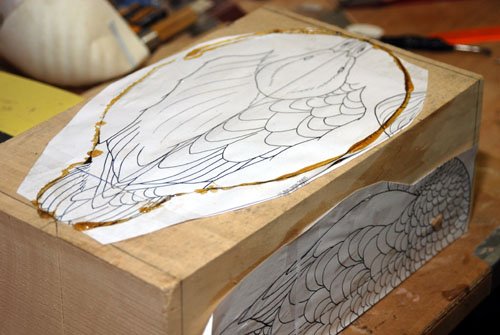 |
|
24. With the three pieces glued together, the block is ready for making the cut around the side pattern. |
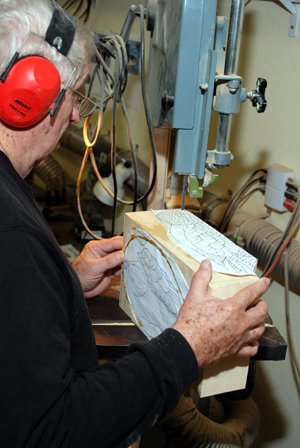 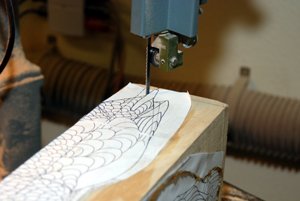 |
|
25. Byrn first cuts around the tail and primaries at the rear of the body. |
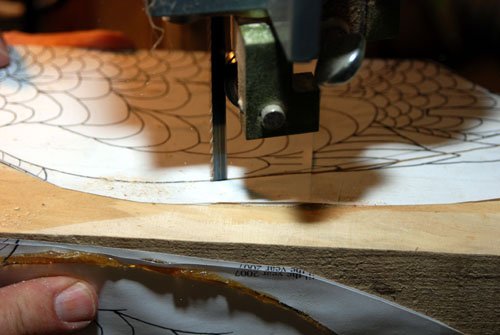 |
|
26. Then, he proceeds to cut around the back to the front of the bird. Remember, since Byrn used the bottom of the block as the bottom of the bird, no bottom cut is necessary. |
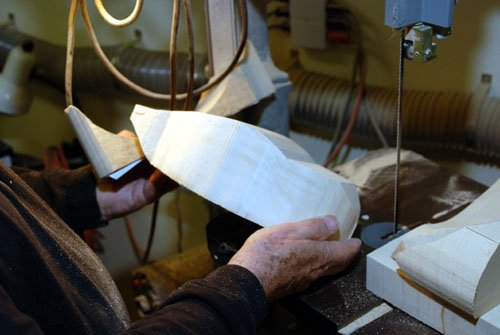 |
|
27. When the cut on the side pattern is completed, scrap pieces fall away and the body roughout is complete. |
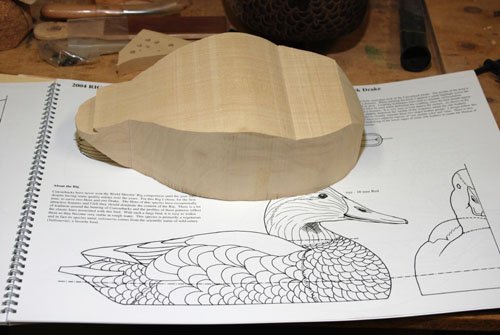 |
|
Byrn's roughout now moves on to another IWCA carver for the next step in shaping the body. We'll choose a head, add some detail, then prep and paint. Stay with us as we bring this decoy to life. |
